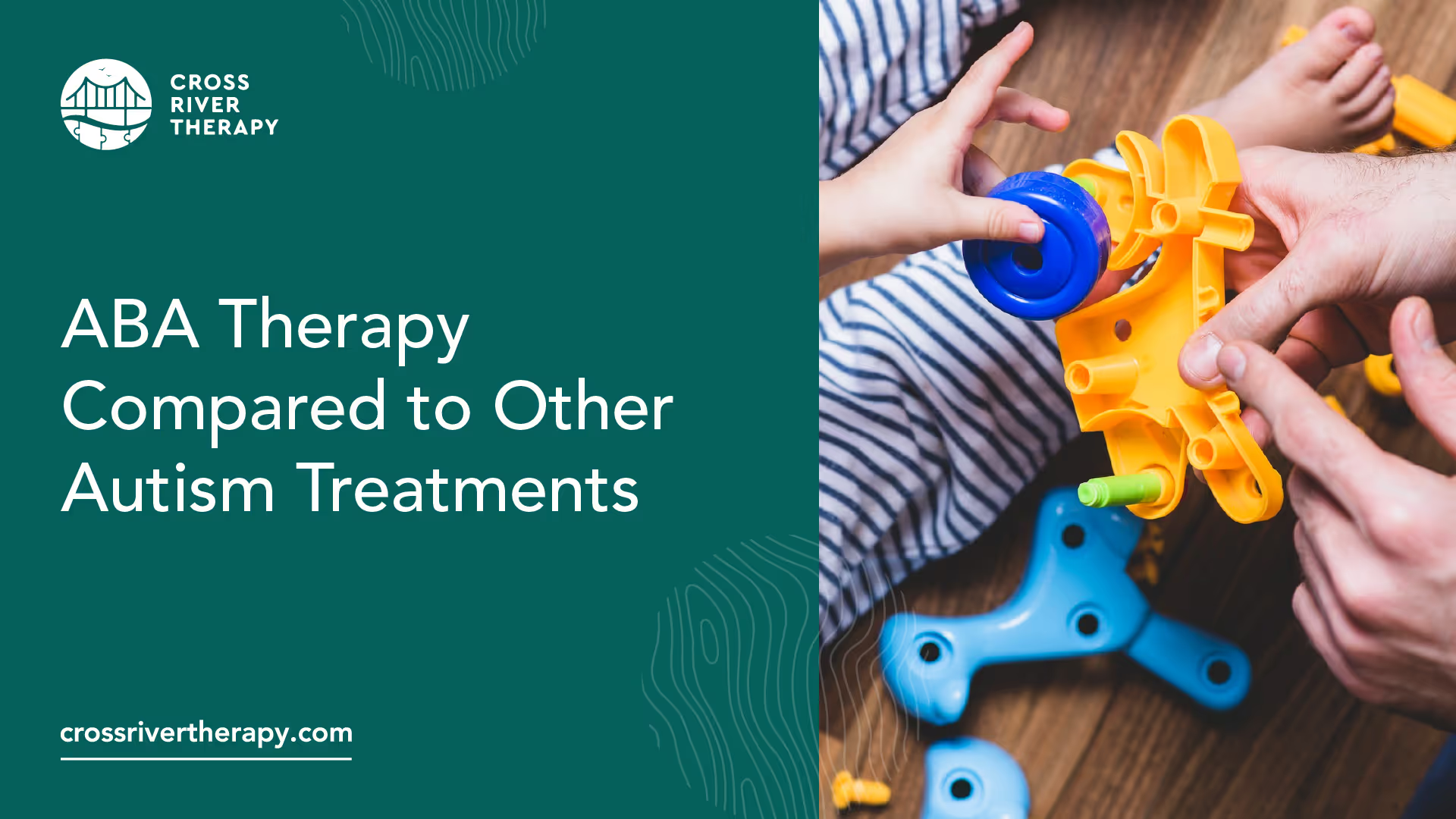ABA Therapy Compared to Other Autism Treatments
Discover the power of ABA therapy compared to other autism treatments.
Understanding ABA Therapy
ABA therapy, or Applied Behavior Analysis therapy, has been a widely used and effective treatment approach for individuals with autism and related developmental disorders since the 1960s [1]. It is considered an evidence-based best practice treatment by the US Surgeon General and the American Psychological Association [1]. In this section, we will explore the history, effectiveness, and the role of behavior analysts in ABA therapy.

History and Effectiveness
ABA therapy was first developed by behaviorist B.F. Skinner, who believed that behavior could be shaped through positive reinforcement and environmental modifications. Over the years, ABA therapy has evolved and proven to be highly effective in improving the lives of individuals with autism.
The therapy focuses on teaching necessary skills and reducing harmful behaviors, with a primary goal of enhancing the individual's quality of life. ABA therapy has shown significant success in various areas, including communication skills, social interactions, and daily living skills [1]. It is designed to be highly individualized, taking into account the unique needs and strengths of each person undergoing therapy.
Role of Behavior Analysts
In ABA therapy, a qualified and trained behavior analyst, often referred to as a Board Certified Behavior Analyst (BCBA), plays a crucial role in designing and overseeing the therapy program. The BCBA customizes the therapy to each learner's skills, needs, interests, preferences, and family situation. They have the expertise to assess and evaluate the individual's behavior, create effective intervention strategies, and monitor progress throughout the therapy process.
Additionally, ABA therapy programs involve therapists, known as Registered Behavior Technicians (RBTs), who are trained and supervised by the BCBA. RBTs provide direct therapy services to individuals with autism, implementing the behavior intervention plans created by the BCBA. They work closely with the BCBA to ensure consistency and progress in the therapy goals [1].
The collaborative efforts of behavior analysts and therapists in ABA therapy contribute to the comprehensive and personalized approach that is essential for achieving positive outcomes. To find qualified ABA therapists in your area, you can refer to our article on finding qualified ABA therapists.
Understanding the history, effectiveness, and the role of behavior analysts in ABA therapy provides valuable insights into the foundations of this treatment approach. In the following sections, we will explore the components of ABA therapy, the benefits it offers, as well as criticisms and alternative perspectives to provide a well-rounded view of this treatment option for individuals with autism.
Components of ABA Therapy
When it comes to ABA therapy, there are specific components that make it a unique and effective treatment for individuals with autism. These components include the involvement of therapists and technicians, as well as the customization and tailoring of the therapy to meet the specific needs of each individual.

Therapists and Technicians
ABA therapy programs are designed and overseen by a qualified and trained behavior analyst, often referred to as a Board-Certified Behavior Analyst (BCBA). The BCBA plays a crucial role in the development and implementation of the ABA program, ensuring that it is tailored to each learner's skills, needs, interests, preferences, and family situation. They provide guidance and supervision to therapists and technicians who directly deliver the therapy.
Registered Behavior Technicians (RBTs) or therapists are trained and supervised by the BCBA. They are responsible for implementing the therapy plan and working directly with the individual with autism. The therapists or technicians receive ongoing training and support from the BCBA to ensure the therapy is conducted effectively and in line with the individual's goals and needs.
Customization and Tailoring
One of the key strengths of ABA therapy is its ability to be highly individualized and tailored to each child with autism. The therapy plan is customized to support the growth and development of each unique individual, providing flexibility and versatility in treatment. The BCBA takes into account the individual's skills, needs, preferences, interests, challenges, and family situation when designing the therapy program.
Through this customization, ABA therapy can address a wide range of skills and behaviors, including communication, social relationships, self-care, and more. The therapy plan is continuously modified and adjusted based on the progress and individual needs of the person undergoing therapy. This personalized approach ensures that the treatment focuses on the specific areas that require improvement and provides targeted interventions.
By involving qualified therapists and technicians and providing a highly customized approach, ABA therapy offers a comprehensive and individualized treatment for individuals with autism. This tailored approach aims to improve various aspects of an individual's life, fostering growth and development in areas that are most meaningful to them.
Benefits of ABA Therapy
When it comes to treating autism, ABA therapy has gained recognition and support for its effectiveness. This evidence-based approach has shown significant benefits for individuals with autism, particularly in terms of cognitive and social improvements, as well as long-term outcomes.

Cognitive and Social Improvements
More than 20 studies have established that intensive and long-term therapy using ABA principles improves outcomes for many children with autism. These studies have demonstrated gains in intellectual functioning, language development, daily living skills, and social functioning. The personalized nature of ABA therapy allows for individual goals to be set based on the child's specific struggles, ensuring a tailored approach to address their unique needs.
ABA therapy focuses on teaching new skills and behaviors while reducing challenging behaviors through reinforcement and positive interventions. By breaking down complex skills into smaller, manageable steps, individuals with autism can develop essential skills, such as communication, social interaction, and self-care. The therapy promotes learning in a structured and supportive environment, helping individuals with autism reach their full potential.
Long-Term Outcomes
The benefits of ABA therapy extend beyond the immediate improvements in cognitive and social functioning. Research has shown that higher hours of therapy lead to greater and longer-lasting improvements in cognitive function and other areas for children with autism. ABA therapy is intensive, typically requiring a minimum of ten hours per week, with many children receiving 15 to 40 hours weekly. The consistent and intensive nature of the therapy contributes to the positive outcomes observed in studies.
Moreover, ABA therapy equips individuals with autism with the skills necessary for successful integration into various settings, including school, community, and daily life. By addressing their specific needs, ABA therapy helps individuals build independence and adaptability, enabling them to navigate social interactions, academic tasks, and everyday challenges [6].
It's important to note that the benefits of ABA therapy are most significant when the therapy is initiated early and provided consistently. ABA therapy is a personalized approach that takes into account the unique strengths and challenges of each individual, ensuring that therapy plans are tailored to their specific needs. Finding qualified ABA therapists who can provide appropriate and consistent therapy is essential for maximizing the potential benefits of this treatment.
In summary, ABA therapy has been recognized as an evidence-based best practice treatment for individuals with autism. Through its focus on cognitive and social improvements and its emphasis on long-term outcomes, ABA therapy offers hope and support for individuals with autism and their families.
Criticisms of ABA Therapy
While Applied Behavior Analysis (ABA) therapy is widely recognized as an effective treatment for individuals with autism, it is not without its controversies and debates. It is important to explore alternative perspectives to gain a comprehensive understanding of the therapy's strengths and limitations.
Controversies and Debates
One of the criticisms of ABA therapy is rooted in its historical use of punishments alongside rewards. Although punishments are no longer a part of ABA therapy, some critics argue that the therapy can still be repetitive and demanding for children. Concerns have been raised about the intensity and duration of the therapy, suggesting that it may place excessive pressure on children.
Another criticism revolves around the focus of ABA therapy on eliminating undesired behaviors rather than building new skills. Some practitioners argue that therapy should emphasize teaching children what they should be doing rather than solely focusing on what they should not be doing. This perspective highlights the importance of skill-building and promoting positive behaviors.
Alternative Perspectives
Autistic self-advocates offer alternative perspectives on ABA therapy. They argue that ABA aims to make autistic children conform to neurotypical standards, which they believe is not suitable as autistic individuals have unique needs. Some advocates suggest that speech and language therapy, which focuses on building skills and promoting independence, may be a more beneficial approach for autistic children.
Defenders of ABA therapy argue that its goal is not to eradicate neurodiversity in autistic individuals, but rather to enable independence. ABA is based on manipulating environmental variables to bring about behavior change without attempting to alter how the child thinks or feels. Proponents of ABA emphasize that the therapy can help individuals with autism develop essential life skills and improve their overall quality of life.
It's important for parents and caregivers to be aware of these controversies and alternative perspectives when considering ABA therapy for their child. By understanding the range of viewpoints surrounding ABA, individuals can make informed decisions about the most appropriate treatment approach for their loved ones.
Individualized Approach
ABA therapy stands out from other autism treatments due to its highly individualized approach. This approach emphasizes the importance of personalizing therapy plans and implementing goal-oriented interventions tailored to each child's unique needs. By customizing the treatment, ABA therapy can effectively address the challenges faced by children with autism.
Personalized Therapy Plans
A qualified and trained behavior analyst, often a board-certified behavior analyst (BCBA), plays a crucial role in designing and directly overseeing the ABA therapy program. They take into account various factors such as the child's skills, needs, interests, preferences, and family situation. This individualized approach ensures that the therapy plan is specifically tailored to support the growth and development of each unique child.
The therapy plan is flexible and versatile, allowing for adjustments and modifications as necessary. ABA therapy programs may also involve therapists, such as registered behavior technicians (RBTs), who are trained and supervised by the BCBA. These therapists work closely with the BCBA and follow the personalized therapy plan to provide targeted interventions.
Goal-Oriented Interventions
ABA therapy sets individualized goals based on the specific struggles and needs of each child with autism. These goals can encompass a wide range of skills and behaviors, such as communication, social relationships, self-care, and more. The primary aim is to improve the child's quality of life by targeting areas that require attention and support.
Throughout the therapy sessions, therapists continuously assess the child's progress and adjust interventions accordingly. This dynamic approach ensures that the child receives the most effective and appropriate interventions to facilitate growth and development. The emphasis on goal-oriented interventions helps children with autism acquire essential skills and overcome challenges in a structured and systematic manner.
By focusing on personalization and goal-oriented interventions, ABA therapy offers a unique and effective approach to treating autism. This individualized approach allows therapists to address the specific needs of each child, ensuring that they receive the support and guidance necessary to thrive. To learn more about ABA therapy for specific age groups, you can refer to our articles on ABA therapy for adolescents and ABA therapy and school integration.
ABA Therapy for All Ages
ABA therapy is highly effective for individuals of all ages, including children, adolescents, and adults diagnosed with autism. While the therapy may be tailored to suit the specific needs of each age group, the underlying principles and benefits remain consistent. Let's explore the effectiveness of ABA therapy across the lifespan and its application in daily life.
Effectiveness Across Lifespan
According to Autism Speaks, ABA therapy has demonstrated positive outcomes for individuals of all ages. Although the approach may differ depending on the developmental stage, the core principles of ABA remain the same. ABA therapy can be particularly beneficial for adults, as it helps them achieve personal goals and improve their quality of life. It is worth noting that formal therapy funding may become more challenging to obtain after the age of 14. However, many adults with autism continue to apply ABA principles in their everyday lives to support their ongoing development.
Application in Daily Life
ABA therapy focuses on teaching necessary skills and addressing challenging behaviors to help individuals with autism lead safer and more fulfilling lives. The therapy aims to improve various areas, including communication, social relationships, self-care, and more. The ultimate goal is to enhance the individual's overall well-being and independence.
The benefits of ABA therapy extend beyond the therapy sessions. It equips individuals with the tools needed to navigate daily life more effectively. For example, ABA therapy can help individuals identify triggers for harmful or destructive behaviors, develop alternative responses, and improve their communication skills to express their needs safely. By gaining a deeper understanding of the causes behind harmful behaviors, individuals can learn more effective strategies to address and manage them.
In practice, ABA therapy plans are highly individualized and vary based on the unique needs, preferences, challenges, and family dynamics of each person. Board Certified Behavior Analysts (BCBAs) collaborate with individuals and their families to create personalized therapy plans. These plans are then implemented by licensed professionals, such as behavior therapists, under the guidance of the BCBA.
By utilizing ABA therapy, individuals of all ages can acquire valuable skills, improve their communication abilities, and learn effective strategies to navigate daily life more successfully. ABA therapy offers a comprehensive and individualized approach, empowering individuals with autism to make meaningful progress and lead fulfilling lives.
References
[1]: https://www.autismspeaks.org/applied-behavior-analysis
[2]: https://appliedabc.com/what-makes-aba-therapy-different-from-other-autism-therapies/
[3]: https://www.autismspeaks.org/blog/questions-and-answers-about-aba
[4]: https://www.webmd.com/mental-health/what-is-applied-behavior-analysis
[8]: https://childmind.org/article/controversy-around-applied-behavior-analysis/



